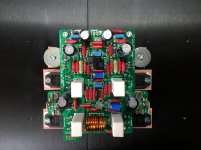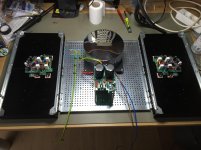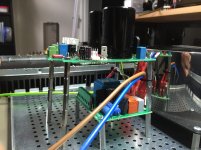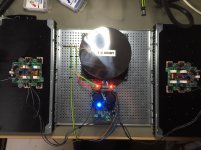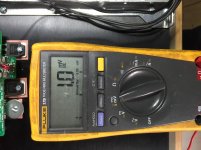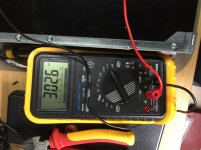the sense transistor controls the output bias current not the output offset.That is a shame. But, problems are there to be solved; how could this problem be tackled according to your expertise? You suggest that it is a problem intrinsic to the design. However, from what I read in this topic you seem to be the only builder that has this problem. Could there not be a different explanation?
I currently have not the facilities to check how my NX behaves, but I am curious to what causes this. Have you tried to improve it by for example putting the sense transistor closer to the heatsinks? Is everything matched etc.?
The front end of the amplifier sets the output offset.
I worked on it for a while and eventually I saw the only sensible ways to do it were either DC servo, or AC couple.
I went for the simplest and AC coupled the input but left the NFB as DC coupled. That leaves the DC gain equal to the AC gain and thus any small errors at the two input pairs gets multiplied by the DC gain to arrive at the output as offset. This has significantly reduced the wandering, but temperature still throws small errors into the mix.
it is not anything to do with DC from the source.
It's the instability of the single ended input stage with respect to temperature.
This is compounded by sensitivity to the source impedance seen by the DC coupled connection.
The pair give rise to an output offset that wanders all over the place compared to an LTP style input stage that is AC coupled.
I had never built a DC coupled amplifier with a single ended input. The NX proved to me how bad that combination is.
What do you call bad Andrew? Please quantify it with numbers and not opinion.
Secondly, its not a single ended input stage. Its 100 percent complementary.
the sense transistor controls the output bias current not the output offset.
The front end of the amplifier sets the output offset.
I worked on it for a while and eventually I saw the only sensible ways to do it were either DC servo, or AC couple.
I went for the simplest and AC coupled the input but left the NFB as DC coupled. That leaves the DC gain equal to the AC gain and thus any small errors at the two input pairs gets multiplied by the DC gain to arrive at the output as offset. This has significantly reduced the wandering, but temperature still throws small errors into the mix.
Thanks for elucidating Andrew 🙂 Interesting. Unfortunately I have no proper heatsinks at the moment, but will post some updates when I am able to test it.
And Sjoerd, how does it sound? 😀
Ofset of left amp after 10 min.
That's correct Sjoerd - and it should be to within that level after repeated on/off cycles from cold.
With the complementary input structure on CFA amps as used in the sx and nx designs, the ~600mV Vbe's cancel leaving only small differences due to the transistors themselves of worst case 20mV. Thisis what gets dialled out with the offset pot plus any imbalance in the TIS stage halves.
Wrt thermal stability, the input pair and the buffer pair run at the same collector current, there is therefore a first order cancellation of the dVbe - i.e. Vbe changes due to temperature gradients across the 4 transistors.
As I remarked in the write up, for such a simple circuit, with low feedback, the thermal stability is very good.
Wrt thermal stability, the input pair and the buffer pair run at the same collector current, there is therefore a first order cancellation of the dVbe - i.e. Vbe changes due to temperature gradients across the 4 transistors.
As I remarked in the write up, for such a simple circuit, with low feedback, the thermal stability is very good.
Haha Michael, don't hear a thing! ;-)
First I want to be absolutely sure all is within proper MV's before finishing the amp. So tonight will be on-of night 🙂
First I want to be absolutely sure all is within proper MV's before finishing the amp. So tonight will be on-of night 🙂
numbers:What do you call bad Andrew? Please quantify it with numbers and not opinion.
Secondly, its not a single ended input stage. Its 100 percent complementary.
LTP with a thermally coupled pair using an AC coupled topology can achieve better than ±2mV of off set within a couple of seconds of start up.
The DC coupled topology using two sets complementary single ended inputs does at least ±50mV from cold to fully warmed up with well matched pairs of the recommended devices. I tried 546/556 and 550/560 input sets and both behaved similarly. And even worse with poorly matched sets.
That's not opinion.
But my opinion stays the same, combining DC coupled topology with single ended results in wandering of output offset.
Current is stable now. Switched on and off 7 times and comes back to good value every turn. Now for the ofset....
shorting the input gives a different output offset from an open input and with a source connected one gets an offset that is between those two extremes.
That's what I was talking about earlier.
post1919
I need to add: The NX has been my main amplifier for the past 2 to 3 months.
That's what I was talking about earlier.
post1919
Adding the DC blocking cap to the input removes this change of offset when trying out other equipment..This is compounded by sensitivity to the source impedance seen by the DC coupled connection..
I need to add: The NX has been my main amplifier for the past 2 to 3 months.
Last edited:
- Home
- Amplifiers
- Solid State
- SX-Amp and NX-Amp
